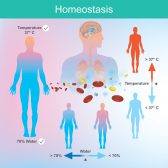mechanism
The manner of combination of parts, processes, etc., which subserve a common function.
Origin: Gr. Mechan = machine
You will also like...

Physiological Homeostasis
Homeostasis is essential to maintain conditions within the tolerable limits. Otherwise, the body will fail to function properly. The body does this through feedback control mechanisms, e.g. blood sugar level regulation and temperature regulation. Read this tutorial to know more about the principles of negative feedback control employed by the body to sustain homeostasis...

Homeostatic Mechanisms and Cellular Communication
Homeostasis is the relatively stable conditions of the internal environment that result from compensatory regulatory responses performed by homeostatic control systems. Know the different components of homeostatic control systems, homeostatic regulators, and the various biological processes that homeostasis entail...

Circulation
The circulatory system is key to the transport of vital biomolecules and nutrients throughout the body. Learn about the different components and functions of the human circulatory system dealt with in detail in this tutorial. The lymphatic system is also elucidated elaborately here...

Growth and Plant Hormones
Plants, like animals, produce hormones to regulate plant activities, including growth. They need these hormones to respond well to their environment and to sustain growth, development, and dispersal. Plant biologists recognize five major groups of plant hormones: auxins, gibberellins, ethylene, cytokinins, and abscisic acid. Find out in this guide the importance of each hormone in the life of a plant...

Movement of Molecules Across Cell Membranes
Molecules move within the cell or from one cell to another through different strategies. Transport may be in the form of simple diffusion, facilitated diffusion, active transport, osmosis, endocytosis, exocytosis, epithelial transport, or glandular secretion. This tutorial provides elaborate details on each of these mechanisms. Find out how. ..




